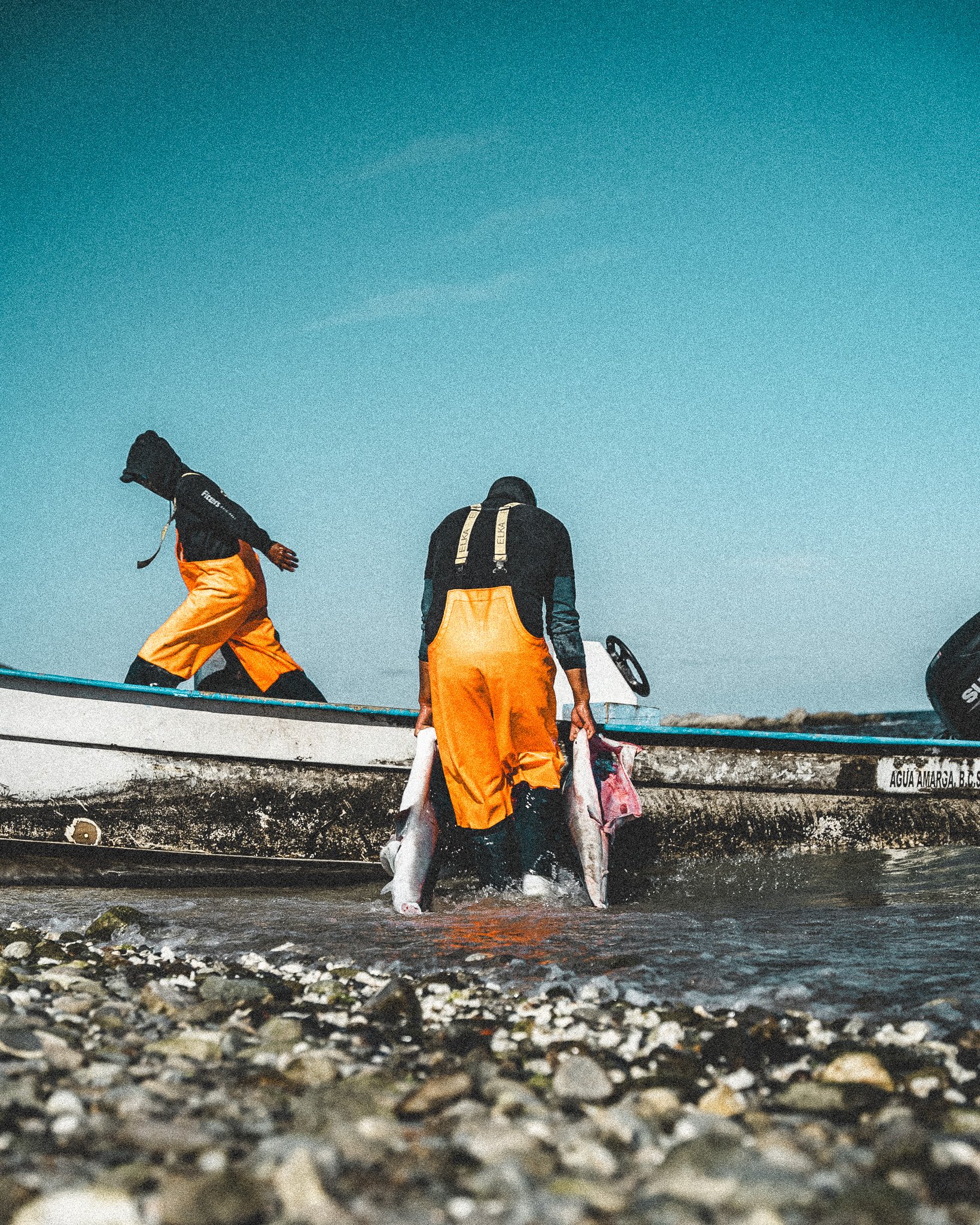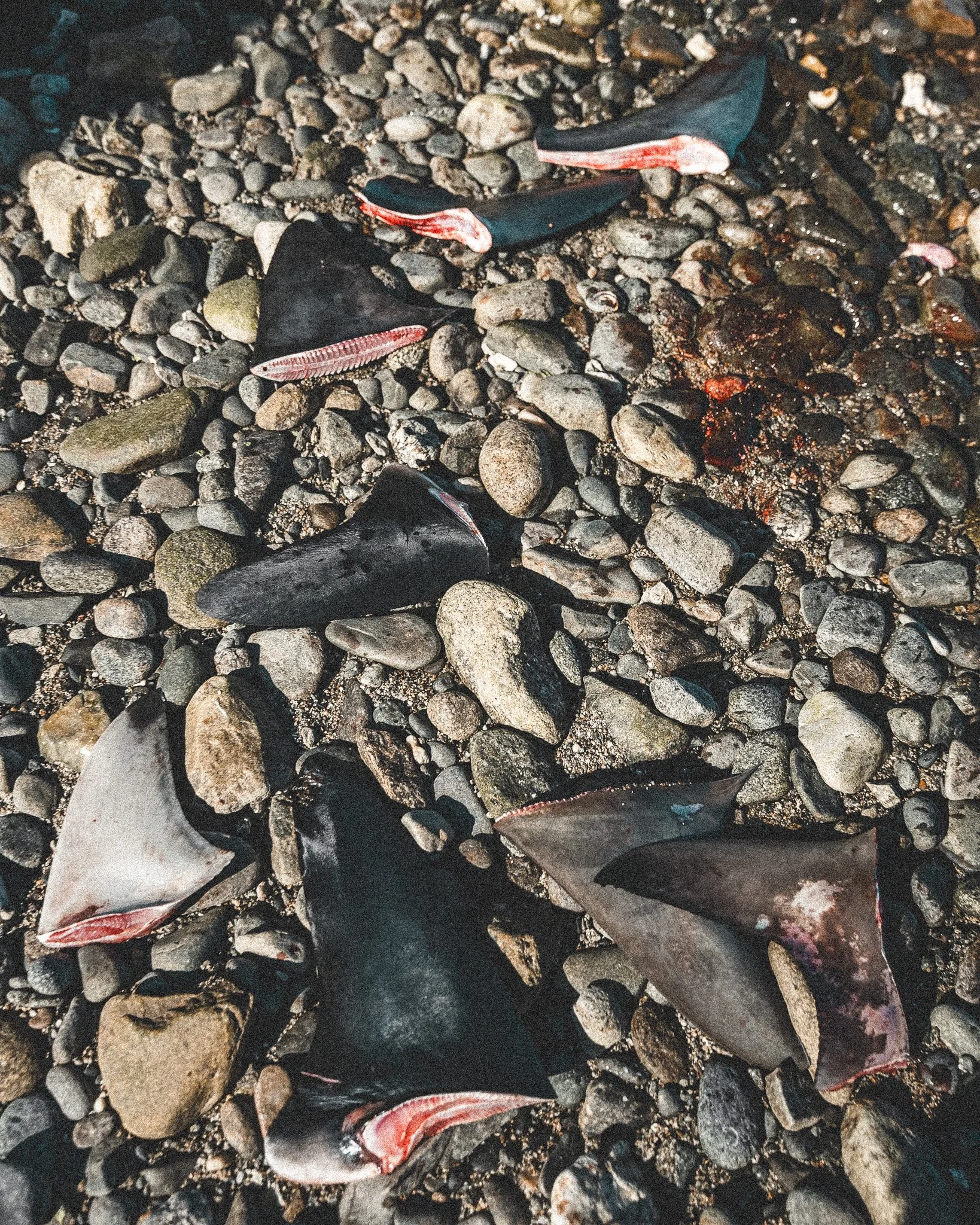SHARK FISHING COMMUNITY RECONVERSION
We’re collaborating with a Mexican NGO called Orgcas who have been working for a few years to help a shark fishing community find alternative incomes in order to have a livelihood that doesn’t rely on shark fishing.
This community is one of the biggest artisanal shark fishery in Baja California Sur.
They have been doing it for generations and, thanks to the amazing work of Orgcas, they have opened us their doors in order to help them transition to another livelihood.
Deep Sea Guardians helped the project for the last 2 years by creating visual content to promote the project and by bringing visitors to support the project financially.
On the left photo, Zimy, Deep Sea Guardians founder together with Pancho, leader of the shark fishing community.
ARTISANAL SHARK FISHING
The location where these fishermen are fishing is a unique place with an amazing diversity of shark species.
In order to fish for sharks, they have a system called “simpleras” which basically is a buoy anchored a few thousand meters deep with a bag full of sand. There’s another fishing line attached to that buoy with a plastic bottle, a hook and a bait.
The fishing system stay at sea all the time except from beginning of May to end of July during the shark fishing ban.
Every morning, the fishermen head out at sea to check every single “simpleras” to see if they hooked any shark. If a shark is hooked, they take it on board, they then put a new bait on the hook and leave it for the next 24 hours.
SHARK SPECIES
All shark species can be fished in these waters except 3: Great White Sharks, Whale Sharks and Basking Sharks (which can’t be found in these Mexican waters anyway).
All other shark species, including critically endangered species such as the Scalloped Hammerheads can be legally fished.
Below, find an overview of the most common species that are being fished in these waters.
HAMMERHEADS
All Hammerhead species are among the most endangered species of sharks.
There are several reasons to it but the main ones are the fact that they are highly susceptible to stress meaning that once they are hooked, they have a very low survival rate.
They can only survive about 15-20min once hooked on a line. We have never seen them still alive and swimming when checking the “simpleras”.
Moreover, the skin structure of their fins makes it one of the most valuable on the market in Asia meaning that fishermen are also more likely to target this species of shark.
PROCESSING THE SHARKS
Once the fishermen checked all their buoys and gathered all the sharks caught, they head to a small hidden beach to process the sharks without being seen and judged by random people.
They already had bad experiences with people walking by and judging them for what they do, posting content on social medias without knowing anything about the subject and the context which is the reason why they are now doing it away from people.
Once on the beach, the unload all the sharks and start cutting them.
They first cut off the head. They either throw it back at sea or keep it to sell jaws and teeth in markets.
All the fins are cut and gathered in a basket.
Finally, they empty the body of the sharks to keep just the meat and then load everything back on the boat to head back home.
LESS AND LESS SHARKS
The fishermen are seeing the change first hand and the impact is real: they have to go further out at sea and catch fewer and smaller sharks than the previous generations used to.
The fact that the sharks they catch are smaller shows that the population is under pressure which could ultimately lead to a complete collapse of the shark populations in the area in a near future.
One of the fishermen told us that their grandparents used to catch Great Hammerheads and Oceanic White Tips in the area but they are now completely gone and can’t be found there anymore…
These artisanal fisheries are the shark fisheries that have the least impact. They definitely do have an impact but it is a lot less than the huge industrial fishing boats operating in the area as well.
Industrial fishing fleets catch a lot more sharks and with a lot less efforts than the fishermen we’re trying to help which also causes a decrease in the price of the sharks which is directly impacting the artisanal fishermen as well.
On this photo, you can see all the sharks that the fishermen caught during a morning we spent with them.
From left to right: Scalloped Hammerhead, Mako, Mako, Blue, Blue, Mako, Pacific Sharp Nose, Pacific Sharp Nose.
TOO MUCH PRESSURE DESPITE THE SHARK FISHING BAN
The Mexican government created a shark fishing ban that extends from beginning of May until end of June or July depending on the exact location.
The shark fishing ban is supposed to protect sharks during their reproduction cycle.
Unfortunately, not all shark species reproduce at the same time of year meaning that some species such as Blue Sharks reproduce outside of the fishing ban period.
On this photo Zimy captured, you can see a pregnant Blue Shark that was caught legally while being pregnant simply because the ban can’t cover all the species.
In order to protect all the species, the shark fishing ban would have to be much longer but, then, it wouldn’t give the fishermen enough fishing time to make a living…
This is why the only way to truly protect these sharks is to help the fishermen find alternative sources of income so they can slowly stop fishing sharks and sustain their families doing something else.
WHAT IS IT WORTH ?
Whenever we’re out at sea with the fishermen, if we find a shark that has been hooked but is still alive on the line, we ask the fishermen to release the animal.
In order for the fishermen not to lose money because of us, we pay them the same amount they would get from selling the shark.
On the photo, you can see a juvenile Tiger shark that was still alive when we arrived, we released the shark and the fishermen asked 50usd, which is what they would get from a shark like that.
We also released several fully grown Blue Sharks and they asked less than 100usd…
The most valuable part of the shark are the fins. All the fins are sent to Asia for the famous shark fin soup.
The bodies and meat is the least valuable part. It is usually not exported. It stays in Mexico and it is consumed as fish tacos or ceviches.
A DIFFICULT JOB
Pancho is the leader of this shark fishing community. He’s the one that welcomed us and allowed us to record what they do.
He tells it himself: being a shark fisherman is a very difficult and dangerous job.
They have to go out at sea every single day. If they don’t go out, they don’t make money meaning that sometimes the ocean is extremely rough and dangerous but they are out there with their small boat not knowing if they’ll be able to make it back home.
If they don’t catch enough sharks, they’ll even lose money because of the fuel expenses they have to pay.
Pancho explained that he never wanted to take his son out at sea because he wanted to avoid having him falling in love with the ocean and becoming a fisherman as well because he always knew how hard and difficult this job was.
Instead, he always pushed his son to study and he recently successfully graduated college !
ALTERNATIVE INCOMES
In order to protect sharks, we have to help the people that depend on them too !
This is why Orgcas helped the fishermen create an eco-tourism business which is bringing them an alternative source of income allowing them to slowly stop fishing sharks.
We’re collaborating with Orgcas to help them reach more people and develop the program in order to bring more money from tourism to the fishermen.
One day, they’ll hopefully be able to fully make a living bringing tourists out in the ocean to see the beauty of this place instead of having to fish for sharks.
During our 2023 Mexico Expedition, we brought our guests there to spend a couple days with them, learning their story and looking for wildlife in the ocean.
Some of the shark fishermen already completely stopped fishing sharks.
For example on this photo, you can see Pancho on the left, and next to him is Felix.
Felix used to be a full time shark fishermen and he completely quit to now fully focus on tourism.
Since the beginning of 2023, Felix is now making a living bringing tourists out in the ocean to see Mobula Rays, Humpback Whales, Sharks and more, in the exact same location he used to fish for sharks his entire life…
The fishermen are also fully involved in shark research.
For example, the tagging of the Mako Sharks we did (click here for more infos) was done in collaboration with the fishermen.
The sharks we tagged were Makos that got hooked at their buoys but that were still alive.
The fishermen held them still while we tagged them and we then safely released the sharks back in the wild.

































